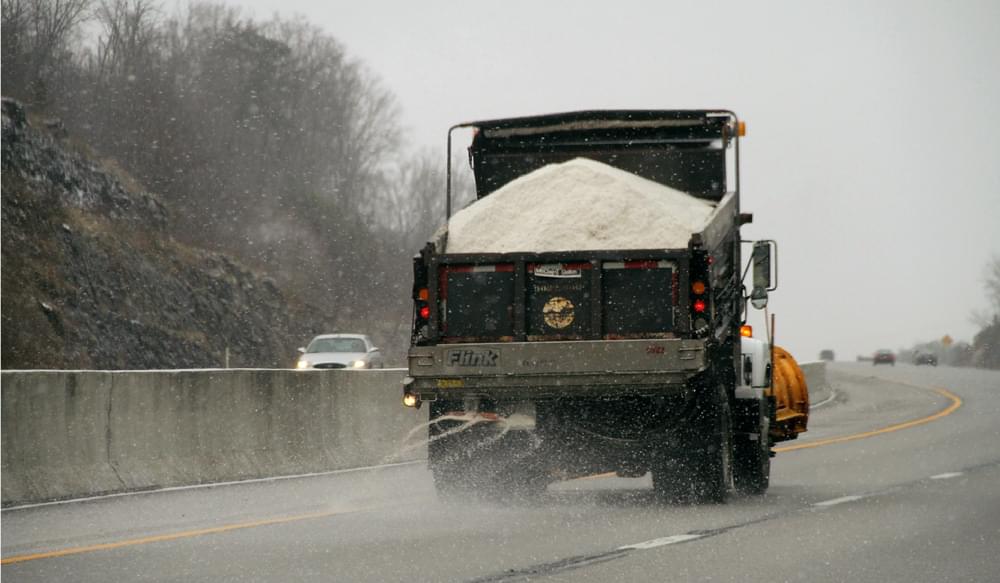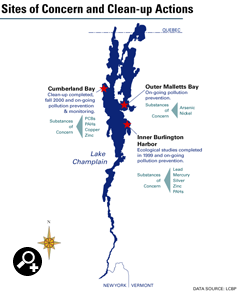Toxic Substances

A variety of contaminants that pose a potential risk to human health and wildlife are found in Lake Champlain. Although levels of toxic substances are low compared to more industrialized areas and progress has been made recently, there is still cause for concern.
A survey of Lake bottom sediments showed elevated levels of mercury in many parts of the Lake, and several other toxic substances in specific locations. New York and Vermont have issued fish consumption advisories for some fish species as a result of elevated levels of mercury and polychlorinated biphenyls (PCBs). In June 2012, New York removed special consumption advisories for Cumberland Bay, after data revealed declining PCB concentrations in fish tissue from this area. Scientists are studying mercury concentrations in fish to understand why levels have risen again after a period of decreases. Lead has harmed loons and other waterfowl. Legislation banning the sale of lead sinkers less than one-half ounce was enacted in New York in 2004 and Vermont in 2007.
In 2012, the LCBP released a new Toxic Substance Management Strategy as a guide for resource managers working in the Lake Champlain Basin. The document is a plan to reduce toxic contamination in Lake Champlain to promote a healthy ecosystem and protect public health as outlined in Lake Champlain’s management plan Opportunities for Action. The Toxic Substance Management Strategy identifies an approach for monitoring and reducing several classes of toxic substances found within the Lake Champlain watershed , and follows the Precautionary Principle. The precautionary principle states that when there are suspected health or environmental concerns, preventative actions should be taken even when there is not a scientific certainty that harm will ensue. This means that the uncertainty associated with the chemicals found in Lake Champlain and their effects should not preclude management nor actions to reduce and prevent contamination. This strategy will be implemented at multiple levels, including individual, private industry, municipalities, and by the Lake Champlain Basin Program, Vermont Agency of Natural Resources, New York Department of Environmental Conservation, and Quebec’s Ministère de l’Environnement et la Lutte contre les Changements Climatiques.
Toxic Substances of Concern
In 2012, the Lake Champlain Basin Program and partners reviewed groups of toxins found to-date in Lake Champlain and identified specific contaminants within these groups as substances of concern. These substances are listed in the 2012 Lake Champlain Toxic Substance Management Strategy, which identifies sources of these substances and provides general recommendations or approaches for reducing these substances in the Lake Champlain watershed.
| Group | Contaminants |
| Pesticides | herbicides, insecticides, fungicides |
| Pharmaceuticals and Personal Care Products (PPCPs) | medications, antibiotics, antidepressants, fragrances, surfactants, detergent metabolites, antimicrobial additives |
| Trace Elements | arsenic, manganese, cadmium, chromium, lead, nickel, silver, zinc, copper |
| Road Salts | NaCl, CaCl |
| Cyanobacterial toxins | aycrocystin, anatoxin |
| Other contaminants | PCBs, mercury, dioxins/furans, chlorinated phenols, PBDEs, persistent organics, solvents |
Sites of Concern in Lake Champlain
Most toxic substances found in Lake Champlain occur at levels that do not pose a known threat to human health; however, a few areas in the Lake have toxic substances found in higher concentrations than in the rest of the Lake, or are found together at one location. The three sites are Outer Malletts Bay, Inner Burlington Harbor, and Cumberland Bay.
In 2000, a $35 million cleanup of Cumberland Bay led by the NYS Department of Environmental Conservation removed PCB-contaminated sediments and restored wetlands and beaches. Monitoring programs in this area have demonstrated that the clean-up effort was successful; in 2012, NYS Department of Health removed the special consumption advisory for fish caught in this bay as a result of significant declines in PCB levels in fish tissue measured in Cumberland Bay. Ongoing pollution prevention continues at Outer Malletts Bay and ecological studies were completed in 1999 for Inner Burlington Harbor.
Reduction and prevention actions will continue to be targeted to these sites of concern. While it is understood that these areas may not be the only sites of concern, they are sites where action to reduce and prevent contamination by toxic substances should begin. Areas where future problems can be prevented will also be targeted for pollution prevention activities.
In addition to the sites noted above, the Pine Street Barge Canal is also an area of toxic contamination near Lake Champlain. This federally designated Superfund site is under remediation through a program led by the US Environmental Protection Agency. Visit the EPA’s Pine Street Canal fact sheet for more information.
Law Island is a recent toxic clean-up success story. This 8.5-acre island, located north of Burlington, VT off Colchester Point, was until summer 2012 a potential source of toxic contaminants. Law Island was the site of five dilapidated and abandoned structures, two abandoned junk cars, and associated refuse. Tests conducted in 2007 demonstrated lead and asbestos contamination from the materials on the island. With LCBP funds provided by the Great Lakes Fishery Commission and in partnership with the VT Agency of Natural Resources and the Town of Colchester, this extremely disturbed site with lead and asbestos contamination was remediated to the point that it is no longer an environmental hazard and now serves as both wildlife habitat and a recreation site.
For information on other types of toxins, please visit the “Pollutants of Concern” page of our State of the Lake website.
For additional maps and information, please visit the Lake Champlain Basin Atlas.
